“Solicitous care for living things affords satisfaction to one of the most lively instincts of the child’s mind. Nothing is better calculated than this to awaken an attitude of foresight.” – Dr. Maria Montessori
Care of the environment, including care of plants and animals, is part of the Practical Life curriculum and an 
When observing children as part of her early childhood education research, Dr. Montessori noticed that children gain immense satisfaction from caring for living things. This is why classrooms at La Prima Casa Montessori have been homes to various animals, including fish, bunnies and guinea pigs.
Having your child take care of family pets can be a way of bringing the Montessori philosophy into your home. It develops a number of skills along with many positive character traits, which helps in the development of the “whole child.”
Five Ways Pets Support Montessori Learning
1. When caring for pets, children learn how to express love, empathy, compassion and respect for other living things. This is part of Cosmic Education – a cornerstone of the Montessori Philosophy, which teaches the interconnectedness of all things.
2. Having pets to care for helps students learn responsibility and gain self-confidence. Whether remembering to feed the pet on time or clean after it, children enjoy taking care of their little friends while learning how to be responsible and empowered.
3. Learning grace and courtesy in the way they treat animals helps children extend those concepts to their interactions with others. Kids get to practice using gentle touches with animals by petting them softly and treating them respectfully.
4. Ability to understand and properly interpret a non-verbal language is a special skill – and pets offer a great opportunity to master it. For example, when playing together with the pet, a teacher might tell the student: “That sound the bunny is making is him asking for space. Let’s give him some room to feel safe.”
5. Having an animal at home or in the classroom allows children to develop the skills they’ll need when studying science and other school subjects in the future. For example, students get to observe the animal’s habits, grow in curiosity, ask questions, look for clues, make hypotheses and find answers.
To practice Care of Pets at home, set up a station, including pictures, and practice with your child until they get the hang of it on their own. Remember to discuss feeding schedules and quantities! Whether the family pet is a fish, dog, cat, guinea pig, bird or elephant, the lessons that are instilled in a child through caring for animals will remain with them for the rest of their lives.


